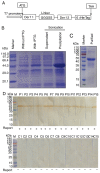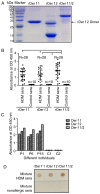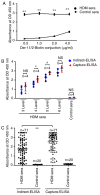Enhanced sensitivity of capture IgE‑ELISA based on a recombinant Der f 1/2 fusion protein for the detection of IgE antibodies targeting house dust mite allergens
- PMID: 30896856
- PMCID: PMC6472038
- DOI: 10.3892/mmr.2019.10050
Enhanced sensitivity of capture IgE‑ELISA based on a recombinant Der f 1/2 fusion protein for the detection of IgE antibodies targeting house dust mite allergens
Abstract
The detection of allergen‑specific immunoglobulin (Ig)E is an important method for the diagnosis of IgE‑mediated allergic diseases. The sensitivity of the indirect IgE‑ELISA method against allergen extracts is limited by interference from high IgG titers and low quantities of effectual allergen components in extracts. To overcome these limitations, a novel capture IgE‑ELISA based on a recombinant Der f 1/Der f 2 fusion protein (rDer f 1/2) was developed to enhance the sensitivity to IgEs that bind allergens from the house dust mite (HDM) species Dermatophagoides farina. pET28‑Der f 1/2 was constructed and expressed in Escherichia coli BL21 (DE3) pLysS. The purified fusion protein was evaluated by IgE western blotting, IgE dot blotting and indirect IgE‑ELISA. Capture‑ELISA was performed by coating wells with omalizumab and incubating in series with sera, biotinylated Der f 1/2, horseradish peroxidase‑conjugated streptavidin and 3,3,5,5‑tetramethylbenzidine. The relative sensitivities of indirect‑ELISA and capture‑ELISA for HDM allergen‑specific IgE binding were determined; sera from non‑allergic individuals were used as the control group. rDer f 1/2 was expressed in the form of inclusion bodies comprising refolded protein, which were then purified. It exhibited increased IgE‑specific binding (24/28, 85.8%) than rDer f 1 (21/28, 75.0%) or rDer f 2 (22/28, 78.6%) with HDM‑allergic sera. Furthermore, in a random sample of HDM‑allergic sera (n=71), capture‑ELISA (71/71, 100%) was more sensitive than indirect‑ELISA (68/71, 95.8%) for the detection of HDM‑specific IgEs (P<0.01), indicating that this novel method may be useful for the diagnosis of HDM allergy.
Figures





Similar articles
-
Hypoallergenic Der p 1/Der p 2 combination vaccines for immunotherapy of house dust mite allergy.J Allergy Clin Immunol. 2012 Aug;130(2):435-43.e4. doi: 10.1016/j.jaci.2012.05.035. Epub 2012 Jul 11. J Allergy Clin Immunol. 2012. PMID: 22789398 Free PMC article.
-
Identification of immunodominant IgE epitopes of the major house dust mite allergen Der f 24.Int J Mol Med. 2019 Nov;44(5):1888-1898. doi: 10.3892/ijmm.2019.4345. Epub 2019 Sep 18. Int J Mol Med. 2019. PMID: 31545417 Free PMC article.
-
Cross-Reactivity between Major IgE Epitopes of Family 5 Allergens from Dermatophagoides pteronyssinus and Blomia tropicalis.Int Arch Allergy Immunol. 2019;178(1):10-18. doi: 10.1159/000492871. Epub 2018 Oct 31. Int Arch Allergy Immunol. 2019. PMID: 30380546
-
Der p 1 and Der p 2 specific immunoglobulin E measurement for diagnosis of Dermatophagoides pteronyssinus allergy: A systematic review and meta-analysis.Allergy Asthma Proc. 2017 Sep 1;38(5):333-342. doi: 10.2500/aap.2017.38.4073. Allergy Asthma Proc. 2017. PMID: 28814355
-
Hierarchy and molecular properties of house dust mite allergens.Allergol Int. 2015 Oct;64(4):304-11. doi: 10.1016/j.alit.2015.05.004. Epub 2015 Jun 13. Allergol Int. 2015. PMID: 26433526 Review.
Cited by
-
From skin testing to molecular diagnostics: the precision leap in dust mite allergy diagnosis and clinical translation challenges.Front Allergy. 2025 Jun 5;6:1598575. doi: 10.3389/falgy.2025.1598575. eCollection 2025. Front Allergy. 2025. PMID: 40538626 Free PMC article. Review.
-
Component-Resolved Diagnosis Based on a Recombinant Variant of Mus m 1 Lipocalin Allergen.Int J Mol Sci. 2023 Jan 7;24(2):1193. doi: 10.3390/ijms24021193. Int J Mol Sci. 2023. PMID: 36674705 Free PMC article.
-
Allergenic protein-induced type I hypersensitivity models: a review.Front Allergy. 2024 Oct 17;5:1481011. doi: 10.3389/falgy.2024.1481011. eCollection 2024. Front Allergy. 2024. PMID: 39483683 Free PMC article. Review.
-
Descriptive Comparison of ELISAs for the Detection of Toxoplasma gondii Antibodies in Animals: A Systematic Review.Pathogens. 2021 May 15;10(5):605. doi: 10.3390/pathogens10050605. Pathogens. 2021. PMID: 34063342 Free PMC article. Review.
-
House dust mite allergy in Malaysia: review of research gaps in the current scenario and the way forward.Exp Appl Acarol. 2023 Dec;91(4):509-539. doi: 10.1007/s10493-023-00857-5. Epub 2023 Nov 23. Exp Appl Acarol. 2023. PMID: 37995026 Review.
References
-
- Elkady A. Allergy to Dermatophagoides pteronyssinus (Der p1) and Dermatophagoides farina (Der f1) in patients with atopic asthma. Int J Sci Res. 2015;4:1896–1902.
MeSH terms
Substances
LinkOut - more resources
Full Text Sources
Other Literature Sources

